The global medical far infrared therapy device market is valued at USD 1.3 billion in 2025. It is slated to reach USD 2.1 billion by 2035, recording an absolute increase of USD 845.1 million over the forecast period. This translates into a total growth of 64.1%, with the market forecast to expand at a compound annual growth rate (CAGR) of 5.1% between 2025 and 2035. The overall market size is expected to grow by nearly 1.64X during the same period, supported by increasing demand for non-invasive pain management solutions, growing adoption of home healthcare devices, and rising emphasis on rehabilitation therapy across diverse clinical settings, wellness centers, and residential applications.
Between 2025 and 2030, the medical far-infrared therapy device market is projected to expand from USD 1.3 billion to USD 1,681.7 million, representing a 43.8% increase in value and accounting for 43.8% of the total forecast growth for the decade. This phase of development will be shaped by the increasing prevalence of chronic pain conditions and musculoskeletal disorders, the rising adoption of alternative therapy methods, and the growing demand for portable therapeutic devices in home healthcare settings. Healthcare providers and wellness centers are expanding their far-infrared therapy capabilities to meet the growing demand for drug-free pain management solutions that ensure patient comfort and therapeutic effectiveness.
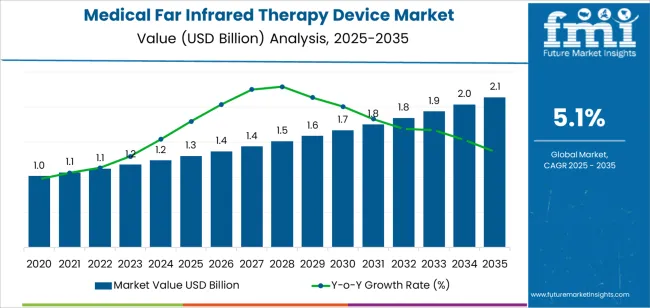
From 2030 to 2035, the market is forecast to grow from USD 1,681.7 million to USD 2.1 billion, adding another USD 474.8 million, which constitutes 56.2% of the overall ten-year expansion. This period is expected to be characterized by the expansion of rehabilitation centers and postoperative recovery programs, the development of advanced wearable therapy devices with integrated monitoring capabilities, and the growth of specialized applications for sports medicine and geriatric care. The growing adoption of telehealth platforms and remote patient monitoring will drive demand for connected far infrared therapy devices with enhanced functionality and therapeutic precision.
Between 2020 and 2025, the medical far infrared therapy device market experienced steady growth, driven by increasing awareness of the benefits of far infrared therapy and the growing recognition of these devices as essential tools for pain management and rehabilitation across diverse clinical and home healthcare applications. The market developed as healthcare professionals and physiotherapists recognized the potential for far infrared technology to improve blood circulation, reduce inflammation, and support tissue healing while meeting patient comfort requirements. Technological advancements in heating element design and temperature control highlighted the critical importance of maintaining consistent therapeutic temperatures and adhering to safety protocols across various treatment environments.
| Metric | Value |
|---|---|
| Estimated Value in (2025E) | USD 1.3 billion |
| Forecast Value in (2035F) | USD 2.1 billion |
| Forecast CAGR (2025 to 2035) | 5.1% |
Market expansion is being supported by the increasing global demand for non-invasive pain management alternatives driven by concerns over opioid dependency and pharmaceutical side effects, alongside the corresponding need for therapeutic devices that can provide effective pain relief, improve blood circulation, and maintain patient comfort across various rehabilitation, sports medicine, and home healthcare applications. Modern healthcare providers and physiotherapy centers are increasingly focused on implementing far infrared therapy solutions that can reduce inflammation, enhance tissue recovery, and provide consistent therapeutic outcomes in diverse treatment conditions.
The growing emphasis on home healthcare and patient self-management is driving demand for portable far infrared therapy devices that can support independent treatment protocols, enable convenient therapy sessions, and ensure comprehensive pain management effectiveness. Healthcare consumers' preference for drug-free therapeutic options that combine treatment efficacy with ease of use and safety is creating opportunities for innovative far infrared device implementations. The rising influence of aging populations and increasing prevalence of chronic conditions is also contributing to increased adoption of far infrared therapy devices that can provide sustained pain relief without compromising patient quality of life or treatment accessibility.
The market is segmented by product type, application, and region. By product type, the market is divided into portable far infrared therapy devices, mattress-type far infrared therapy devices, wearable far infrared therapy devices, large-scale therapeutic equipment-type far infrared devices, and others. Based on application, the market is categorized into rehabilitation therapy, pain management, blood circulation improvement, postoperative recovery support, and others. Regionally, the market is divided into East Asia, Europe, North America, South Asia, Latin America, Middle East & Africa, and Eastern Europe.
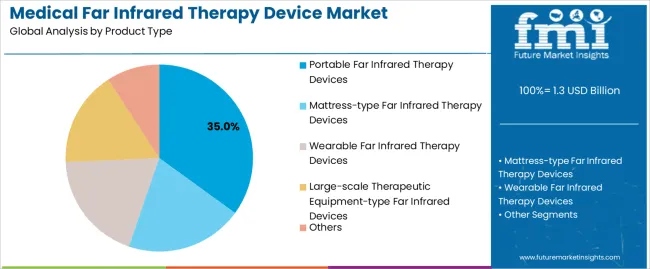
The portable far infrared therapy devices segment is projected to maintain its leading position with 35% market share in the medical far infrared therapy device market in 2025, reaffirming its role as the preferred product category for home healthcare applications and personal pain management. Healthcare consumers and rehabilitation specialists increasingly utilize portable far infrared devices for their convenience, targeted treatment capabilities, and proven effectiveness in delivering localized therapy while maintaining portability and ease of use. Portable device technology's proven effectiveness and application versatility directly address the industry requirements for flexible pain management solutions and accessible therapeutic options across diverse patient populations and treatment scenarios.
This product segment forms the foundation of modern home-based therapy programs, as it represents the device category with the greatest contribution to patient independence and established effectiveness record across multiple pain conditions and therapeutic applications. Healthcare industry investments in patient-centered care models continue to strengthen adoption among consumers and healthcare providers. With demographic shifts requiring accessible pain management options and improved quality of life outcomes, portable far infrared therapy devices align with both patient convenience objectives and therapeutic effectiveness requirements, making them the central component of comprehensive home healthcare strategies.
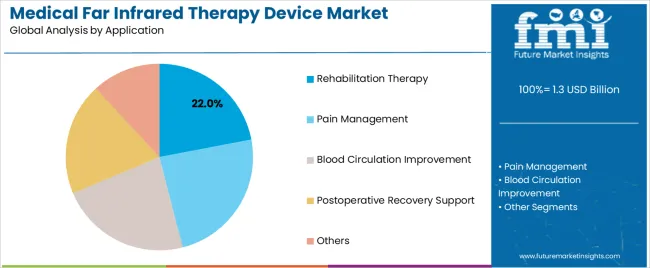
The rehabilitation therapy application segment is projected to represent 22% market share of medical far infrared therapy device demand in 2025, underscoring its critical role as a primary driver for device adoption across physical therapy clinics, sports medicine facilities, and rehabilitation centers. Healthcare professionals prefer far infrared therapy for rehabilitation applications due to its proven ability to accelerate tissue healing, improve flexibility, and enhance recovery outcomes while supporting patient comfort objectives and treatment protocol compliance. Positioned as essential tools for modern rehabilitation programs, medical far infrared therapy devices offer both therapeutic advantages and patient acceptance.
The segment is supported by continuous innovation in rehabilitation methodologies and the growing availability of advanced far infrared devices that enable targeted therapy protocols with enhanced treatment precision and improved patient outcomes. Additionally, rehabilitation centers are investing in comprehensive far infrared therapy integration programs to support increasingly complex recovery protocols and patient demand for effective non-pharmaceutical treatment options. As healthcare systems emphasize functional recovery and patient satisfaction, the rehabilitation therapy application will continue to drive market growth while supporting advanced device utilization and treatment optimization strategies.
The medical far infrared therapy device market is advancing steadily due to increasing demand for non-invasive pain management solutions driven by concerns over medication dependency and growing adoption of alternative therapy methods that provide effective pain relief and therapeutic benefits across diverse rehabilitation, wellness, and home healthcare applications. However, the market faces challenges, including limited clinical evidence for certain therapeutic claims, competition from established physical therapy modalities and pharmaceutical treatments, and pricing pressures related to reimbursement limitations and consumer affordability constraints. Innovation in device technology and clinical validation continues to influence product development and market expansion patterns.
The growing emphasis on home healthcare delivery is driving demand for portable and user-friendly far infrared therapy devices that address patient preferences for convenient treatment options including flexible therapy schedules, independent pain management capabilities, and reduced healthcare facility visits. Home healthcare applications require accessible far infrared devices that deliver consistent therapeutic outcomes across multiple treatment sessions while maintaining safety and ease of operation. Healthcare consumers are increasingly recognizing the practical advantages of home-based far infrared therapy for chronic pain management and ongoing rehabilitation needs, creating opportunities for devices specifically designed for residential use and patient self-administration.
Modern medical far infrared therapy device manufacturers are incorporating digital connectivity and smart monitoring capabilities to enhance treatment precision, enable remote health tracking, and support comprehensive patient engagement through integrated mobile applications and data analytics platforms. Leading companies are developing devices with temperature sensors, treatment timers, and wireless connectivity that allow healthcare providers to monitor patient compliance and adjust therapy protocols remotely. These technologies improve treatment outcomes while enabling new service delivery models, including telehealth-supported therapy programs, remote patient monitoring, and data-driven treatment optimization. Advanced technology integration also allows manufacturers to differentiate product offerings and address healthcare provider requirements for patient outcome tracking.
The expansion of wearable medical devices and increasing consumer acceptance of body-worn therapeutic products is driving demand for wearable far infrared therapy devices with ergonomic designs and targeted treatment capabilities. These advanced applications require specialized device configurations with flexible heating elements and comfortable materials that enable continuous wear during daily activities, creating premium market segments with differentiated value propositions. Manufacturers are investing in textile integration technologies and ergonomic design capabilities to serve active patients and sports medicine applications while supporting innovation in pain management and recovery enhancement strategies.
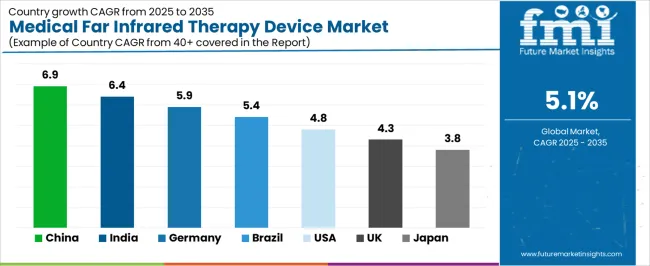
| Country | CAGR (2025-2035) |
|---|---|
| China | 6.9% |
| India | 6.4% |
| Germany | 5.9% |
| Brazil | 5.4% |
| USA | 4.8% |
| UK | 4.3% |
| Japan | 3.8% |
The medical far infrared therapy device market is experiencing solid growth globally, with China leading at a 6.9% CAGR through 2035, driven by expanding healthcare infrastructure, growing middle-class consumer base seeking wellness products, and increasing adoption of traditional medicine-inspired therapeutic devices. India follows at 6.4%, supported by rising chronic disease prevalence, growing awareness of alternative therapies, and expanding rehabilitation center networks. Germany shows growth at 5.9%, emphasizing advanced physical therapy protocols, strong home healthcare adoption, and comprehensive health insurance coverage for therapeutic devices.
Brazil demonstrates 5.4% growth, supported by increasing sports medicine applications, growing wellness industry, and rising consumer interest in non-pharmaceutical pain management. The United States records 4.8%, focusing on home healthcare expansion, chronic pain management needs, and insurance reimbursement development. The United Kingdom exhibits 4.3% growth, emphasizing National Health Service integration and patient self-care initiatives. Japan shows 3.8% growth, supported by aging population healthcare needs and established therapeutic device market maturity.
The report covers an in-depth analysis of 40+ countries top-performing countries are highlighted below.
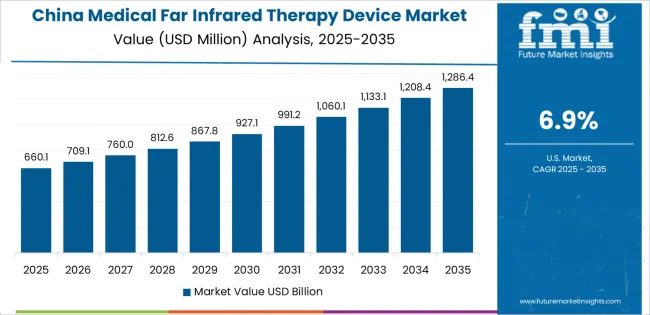
Revenue from medical far infrared therapy devices in China is projected to exhibit exceptional growth with a CAGR of 6.9% through 2035, driven by expanding healthcare infrastructure and rapidly growing consumer wellness market supported by government Healthy China initiatives and traditional medicine integration programs. The country's massive middle-class population and increasing investment in home healthcare technologies are creating substantial demand for far infrared therapy solutions. Major medical device manufacturers and wellness companies are establishing comprehensive production capabilities to serve both domestic markets and export opportunities.
Revenue from medical far infrared therapy devices in India is expanding at a CAGR of 6.4%, supported by the country's growing healthcare infrastructure, increasing prevalence of lifestyle-related chronic conditions, and rising consumer awareness of alternative pain management solutions. The country's expanding middle class and improving healthcare access are driving sophisticated far infrared therapy capabilities throughout diverse urban and semi-urban markets. Leading medical device companies and domestic manufacturers are establishing production and distribution facilities to address growing demand.
Revenue from medical far infrared therapy devices in Germany is expanding at a CAGR of 5.9%, supported by the country's advanced physical therapy infrastructure, comprehensive health insurance coverage, and strong emphasis on evidence-based therapeutic interventions. The nation's healthcare quality standards and established rehabilitation medicine expertise are driving sophisticated far infrared therapy capabilities throughout clinical and home healthcare sectors. Leading medical device manufacturers are investing extensively in clinical validation and product certification for German healthcare standards.
Revenue from medical far infrared therapy devices in Brazil is expanding at a CAGR of 5.4%, supported by the country's growing sports medicine sector, expanding wellness industry, and increasing consumer interest in holistic health approaches. Brazil's active population and cultural emphasis on physical well-being are driving demand for therapeutic devices. Medical device distributors and wellness product retailers are investing in market development to serve both clinical and consumer segments.
Revenue from medical far infrared therapy devices in the United States is expanding at a CAGR of 4.8%, supported by the country's extensive home healthcare market, high prevalence of chronic pain conditions, and growing consumer preference for non-pharmaceutical treatment options. The nation's established medical device market and consumer health awareness are driving demand for therapeutic devices. Manufacturers are investing in FDA compliance and clinical studies to support insurance reimbursement and healthcare provider adoption.
Revenue from medical far infrared therapy devices in the United Kingdom is expanding at a CAGR of 4.3%, supported by the country's National Health Service integration initiatives, growing patient self-care programs, and increasing recognition of complementary therapy benefits. The UK's healthcare system emphasis on cost-effective treatments and patient empowerment is driving interest in far infrared therapy solutions. Medical device suppliers are establishing distribution networks to serve both NHS facilities and consumer markets.
Revenue from medical far infrared therapy devices in Japan is expanding at a CAGR of 3.8%, supported by the country's rapidly aging population, established therapeutic device market, and cultural acceptance of alternative medicine approaches. Japan's technological sophistication and quality standards are driving demand for advanced far infrared therapy products. Leading electronics manufacturers and medical device companies are investing in product innovation for aging population healthcare requirements.
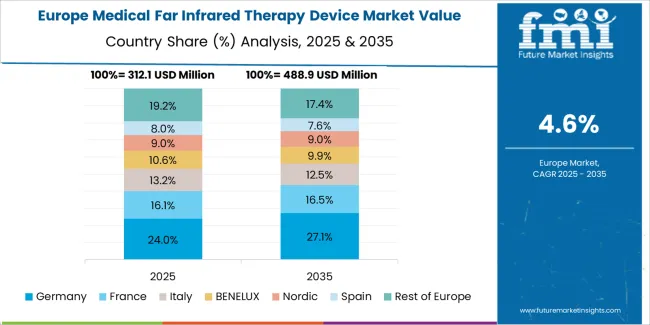
The medical far infrared therapy device market in Europe is projected to grow from USD 356.2 million in 2025 to USD 597.3 million by 2035, registering a CAGR of 5.3% over the forecast period. Germany is expected to maintain leadership with a 28.5% market share in 2025, moderating to 28.2% by 2035, supported by advanced physical therapy infrastructure, comprehensive health insurance coverage, and strong medical device manufacturing excellence.
France follows with 19.3% in 2025, projected at 19.5% by 2035, driven by wellness center expansion, rehabilitation medicine advancement, and growing consumer health awareness. The United Kingdom holds 16.7% in 2025, reaching 16.4% by 2035 on the back of NHS integration programs and patient self-care initiatives. Italy commands 13.2% in 2025, rising slightly to 13.4% by 2035, while Spain accounts for 9.8% in 2025, reaching 10.1% by 2035 aided by sports medicine growth and wellness tourism.
The Netherlands maintains 4.2% in 2025, up to 4.3% by 2035 due to home healthcare adoption and preventive health emphasis. The Rest of Europe region, including Nordics, Central & Eastern Europe, and other markets, is anticipated to hold 8.3% in 2025 and 8.1% by 2035, reflecting steady development in alternative therapy adoption and rehabilitation center modernization.
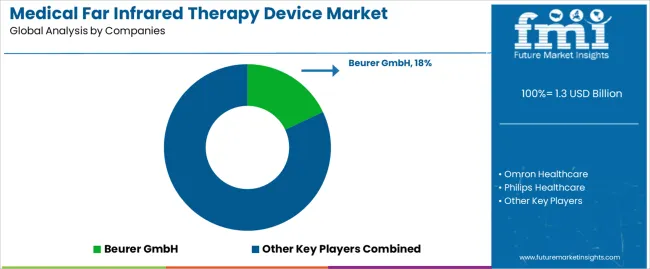
The medical far infrared therapy device market is characterized by competition among established healthcare device manufacturers, wellness product companies, and specialized therapeutic equipment producers. Companies are investing in product safety certification, clinical validation studies, user experience enhancement, and distribution network expansion to deliver effective, safe, and accessible far infrared therapy solutions. Innovation in heating element technology, temperature control systems, and wearable device designs is central to strengthening market position and competitive advantage.
Beurer GmbH leads the market with a comprehensive range of health and wellness devices, offering far infrared therapy products with focus on consumer safety, ease of use, and German quality engineering standards across home healthcare and personal wellness applications. Omron Healthcare provides innovative therapeutic devices with emphasis on clinically validated performance and user-friendly designs. Philips Healthcare delivers integrated health technology solutions with comprehensive far infrared therapy offerings for clinical and home healthcare environments.
Medisana GmbH offers consumer health devices with focus on wellness applications and accessible pricing strategies. Panasonic Healthcare specializes in therapeutic equipment with emphasis on advanced heating technology and product reliability. Thermotex Therapy Systems Ltd. focuses on specialized far infrared therapy products for targeted pain management. Sunbeam Products, Inc. provides consumer wellness devices with widespread retail availability. Zhou Nutrition offers wellness-focused therapeutic products. Chirana Medical, a.s. specializes in medical device manufacturing for European markets. Nuga Best focuses on wellness and therapeutic equipment.
HealthyLine provides premium far infrared therapy products with gemstone integration. Lanaform offers wellness devices for European consumer markets. Bremed specializes in health and wellness products. OSIM International provides luxury wellness equipment with advanced features. Rehan Electronics focuses on therapeutic device manufacturing for emerging markets.
| Items | Values |
|---|---|
| Quantitative Units (2025) | USD 1.3 billion |
| Product Type | Portable Far Infrared Therapy Devices, Mattress-type Far Infrared Therapy Devices, Wearable Far Infrared Therapy Devices, Large-scale Therapeutic Equipment-type Far Infrared Devices, Others |
| Application | Rehabilitation Therapy, Pain Management, Blood Circulation Improvement, Postoperative Recovery Support, Others |
| Regions Covered | East Asia, Europe, North America, South Asia, Latin America, Middle East & Africa, Eastern Europe |
| Countries Covered | China, India, Germany, Brazil, United States, United Kingdom, Japan, and 40+ countries |
| Key Companies Profiled | Beurer GmbH, Omron Healthcare, Philips Healthcare, Medisana GmbH, Panasonic Healthcare, Thermotex Therapy Systems Ltd. |
| Additional Attributes | Dollar sales by product type and application category, regional demand trends, competitive landscape, technological advancements in far infrared therapy, clinical validation development, wearable device innovation, and therapeutic effectiveness optimization |
The global medical far infrared therapy device market is estimated to be valued at USD 1.3 billion in 2025.
The market size for the medical far infrared therapy device market is projected to reach USD 2.1 billion by 2035.
The medical far infrared therapy device market is expected to grow at a 5.1% CAGR between 2025 and 2035.
The key product types in medical far infrared therapy device market are portable far infrared therapy devices, mattress-type far infrared therapy devices, wearable far infrared therapy devices, large-scale therapeutic equipment-type far infrared devices and others.
In terms of application, rehabilitation therapy segment to command 22.0% share in the medical far infrared therapy device market in 2025.






Full Research Suite comprises of:
Market outlook & trends analysis
Interviews & case studies
Strategic recommendations
Vendor profiles & capabilities analysis
5-year forecasts
8 regions and 60+ country-level data splits
Market segment data splits
12 months of continuous data updates
DELIVERED AS:
PDF EXCEL ONLINE
Medical Eye Shield Film Market Size and Share Forecast Outlook 2025 to 2035
Medical Latex Protective Suit Market Size and Share Forecast Outlook 2025 to 2035
Medical Activated Carbon Dressing Market Size and Share Forecast Outlook 2025 to 2035
Medical Coated Roll Stock Market Size and Share Forecast Outlook 2025 to 2035
Medical Billing Outsourcing Market Size and Share Forecast Outlook 2025 to 2035
Medical Pressure Mapping System Market Size and Share Forecast Outlook 2025 to 2035
Medical Chairs Market Size and Share Forecast Outlook 2025 to 2035
Medical Exoskeleton Market Forecast Outlook 2025 to 2035
Medical Display Market Forecast and Outlook 2025 to 2035
Medical Spa Market Size and Share Forecast Outlook 2025 to 2035
Medical Face Shield Market Forecast and Outlook 2025 to 2035
Medical Robot Market Size and Share Forecast Outlook 2025 to 2035
Medical Nutrition Market Forecast and Outlook 2025 to 2035
Medical Wax Market Size and Share Forecast Outlook 2025 to 2035
Medical Specialty Bag Market Size and Share Forecast Outlook 2025 to 2035
Medical Plastics Market Size and Share Forecast Outlook 2025 to 2035
Medical Adhesives Market Size and Share Forecast Outlook 2025 to 2035
Medically Supervised Weight Loss Services Market Size and Share Forecast Outlook 2025 to 2035
Medical Smart Drug Cabinet Market Size and Share Forecast Outlook 2025 to 2035
Medical Anti-Decubitus Air Mattress Market Size and Share Forecast Outlook 2025 to 2035

Thank you!
You will receive an email from our Business Development Manager. Please be sure to check your SPAM/JUNK folder too.
Chat With
MaRIA